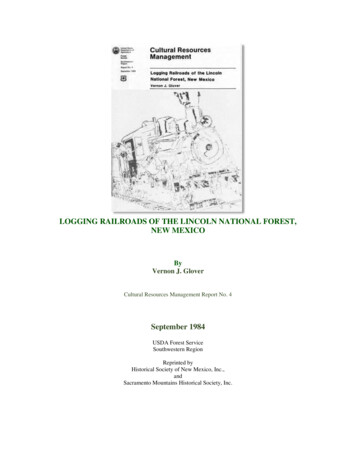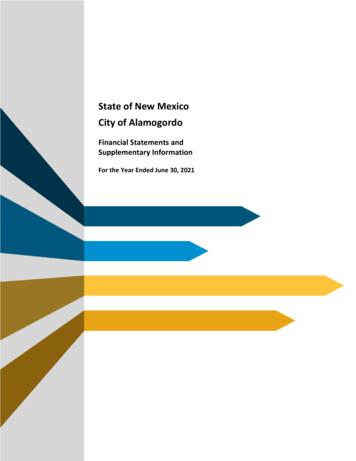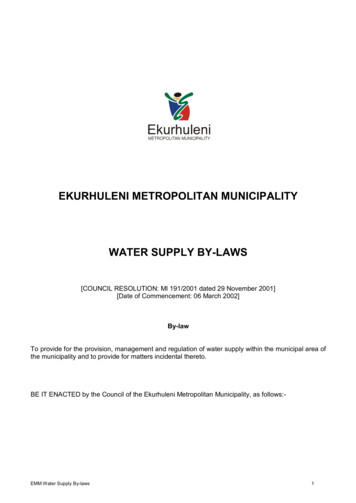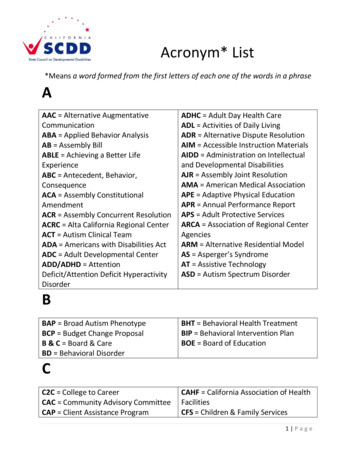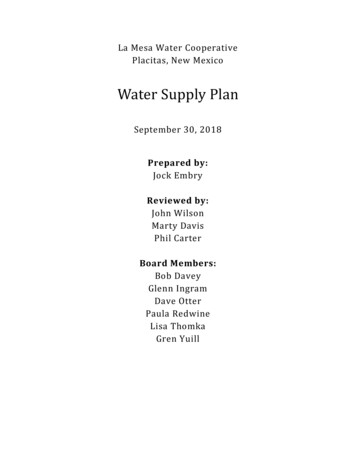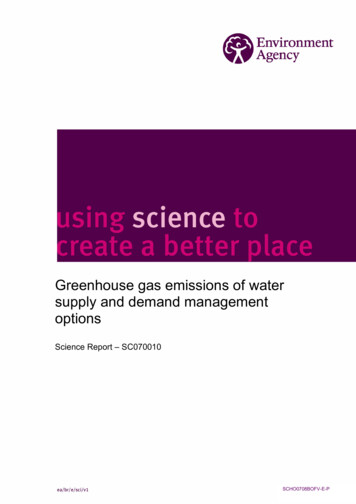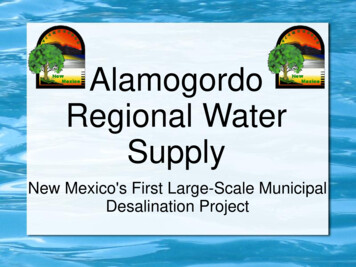
Transcription
AlamogordoRegional WaterSupplyNew Mexico's First Large-Scale MunicipalDesalination Project
Present Water SupplyAlamogordo differs from most municipalities in the State of NewMexico in that the majority of its potable water supply comesfrom surface water. City collects surface water from the Sacramento Mountains located to the eastof the city primarily from the La Luz/ Fresnel and Alamo Canyons. Combinedsurface water rights from these sources is 3,969 afy. The City also pipes surface water from Bonito Lake. Located at the headwaters of the Rio Bonito about 90 miles north of the city. Surface water rightsfrom this source is approximately 1,449 afy. Surface water from Bonito Lake isshared with Holloman Air Force Base which also has water rights totaling 1,449afy. The City lost the ability to draw water from Bonito Lake in 2012 due to theLittle Bear Fire and the subsequent flooding that followed. The City’s main source of groundwater is the La Luz Well Field located northof the city. Additional wells located around the city supplement the La Luz WellField. The City has the right to divert 3,931 afy of groundwater. Howeverbecause of the poor quality of water, not all wells contribute to the city’s potablewater supply.
Supply & DemandBecause of availability and better quality, the City has historicallyrelied heavily on surface water to meet the needs of it citizens.However, increasing population and recent droughts dictate thatsuch heavy reliance on surface water is no longer a viable option. Between 1990 and 1997, 87% of the City’s water supply was available fromsurface flows. From 1997 to 2002, only 55% of the City’s water was available from surfaceflows. As surface flows decreased due to drought, the City was forced to rely onmore groundwater. Increased use from existing groundwater sources is not sustainable becauseof hydrological conditions and poor groundwater quality. As water supplies were decreasing, demand was increasing – the City’s 2000population was 35,582 and according to the University of New Mexico Bureauof Business and Economic Research, the City’s population is projected toincrease to nearly 59,000 by 2045. In the mid-to-late 1990s the City began carefully assessing the existing wateruses and began looking for new sources of water.
Response & Analysis of OptionsIn the early 1990s, the City’s water use was approximately 260gallons per capita per day (“gpcd”). The City implementedconservation measures to drop its per capita water use. In the mid-1990s, the City constructed New Mexico’s first municipal tertiarytreatment wastewater facility whereby all effluent is treated and pumped back tothe City for irrigation use on parks, golf course, recreation fields and openspaces. The City’s water reservoirs were lined and covered to prevent leakage andevaporation. The City passed a number of water conservation ordinances to encouragedecreased water use. The result of the above measures was a reduction from 260 gpcd usage in theearly 1990s to 165 gpcd in the 1999-2001 period – a 40% reduction. Because of the drought that began in the late 1990s and dwindling surfacewater flows the City adopted aggressive ordinances limiting water use andinstituted water use surcharges – these efforts helped further reduce usage toapproximately 140 gpcd – driven by supply rather than demand.
Response & Analysis of OptionsWhile progress continues to be made with conservation, the City isaware that conservation alone cannot provide an adequate,additional source of water for both present and future needs.The City established criteria for a new water supply Drought resistant Good quality that could be blended with City’s existing supplies Independent, complimenting and maximizing the City’s existing resources Large enough to justify scope of project Cost competitive and cost efficientThe City realized that new appropriations of surface and fresh groundwaterwere not feasible. The Sacramento Mountains are fully appropriated and asAlamogordo is located in the Tularosa basin, covered by Basin AdministrativeCriteria, new appropriations of fresh groundwater of any significant magnitudewere restricted.
Response & Analysis of OptionsThe City considered many options for new water supplies including: Buying irrigation water rights to be transferred for municipal use Importation from the Salt Basin Outside bulk water purchases Agricultural water exchange Aquifer storage and recovery Desalination (brackish groundwater is abundant in the Tularosa Basin)The City concluded that the only way to get a large drought-resistantappropriation, without decades of applications for small appropriationsand/or transfers, was to pursue a well field that would divert brackishgroundwater in conjunction with a desalination facility.
Desalination Project The City commissioned a study of possible brackish watersources ranging from 20 miles south of Alamogordo to 30miles north of Alamogordo. Four piloting sites were selected within the study area. Ultimately the Snake Tank Well Field was selected – 26miles north of the City.– Availability of unappropriated brackish groundwater– Large quantity of groundwater in storage– Relatively even and acceptable brackish water quality– Opportunity to gravity flow to treatment plant– Outside the Tularosa Basin Administrative Criteria area
Albuquerque, NM – 200 milesHolloman AFBEl Paso, TX – 90 miles
PermittingIn September 2000, the City filed application T-3825 et al. with theNew Mexico Office of the State Engineer (OSE) seeking a newappropriation of 10,000 AFY of brackish groundwater from ten wells inthe Snake Tank field. In January 2010, the City finally secured rights to 4,000 AFY of brackishgroundwater at the Snake Tank Well Field.During the nearly 10 years the city pursued the groundwater rights for theSnake Tank Well Field, the city continued to address potable water issues: Expanding the use of treated effluent water to irrigate public grounds including schooldistrict fields. Rebuilding and increasing the efficiency of existing groundwater wells. Actively promoting water conservation through public meetings, monthly newslettersand active enforcement of conservation ordinances. Updating the City’s 40 Year Water Plan. Adding storage capacity to maximize surface water collection when available.
Desalination Facility Originally planned to be located on state land near the Snake TankWell field. Now planned to be located across LaVelle Rd. from the BrackishGroundwater National Desalination Research Facility. Based on actual field testing, the City estimates an RO recovery ofabout 80% with blending of untreated water with permeate in anappropriate ratio to achieve potable water of about 800 mg/l TDS. Will be constructed in stages to phase capital costs. At final build-out capacity is estimated to be 2.8 million gallons per dayof potable water. The plant is intended to be a “peaking” facility, or drought reserve,when surface flows and existing groundwater is insufficient to meet thecity’s growing needs.
NEPABecause the Snake Tank Well Field, portions of the pipeline and relatedinfrastructure are on federal lands managed by the U.S. Bureau of LandManagement (BLM), an Environmental Impact Statement (“EIS”) is required.In May 2004, the City entered into a contract with a consulting firm which, at thedirection of BLM, prepared the EIS. As the City was not a co-lead, its only role inthe preparation of the EIS was to ensure that the project description was correctand to pay the consultant. To date, the City has paid over 1,000,000 for thework on the EIS.A Record of Decision (ROD) was issued in favor of the City by the BLM in theSummer of 2012.
ConclusionThe City of Alamogordo’s new desalination project will cost an estimated 54 million toprovide an independent and reliable water supply. The project is not only important to theCity, but also to the region and the continued viability of Holloman Air Force Base. TheCity’s desalination project is expected to work conjunctively with the Tularosa BasinNational Desalination Research Facility in equipping the City’s plant and using nextgeneration products and advances in desalination technology. The desalination facility alsohas the potential to be used by other regional entities in need of commercial, industrial, andmunicipal water supplies.The City has received funding (WTB #80) for the first 15 miles of water transmissionpipeline from the Snake Tank field to the City and is currently in discussion with HollomanAir Force Base on co-use of the Bonito Lake transmission pipeline for brackish water whichwould alleviate, in the short term, the need for approximately 13 miles of new pipeline. TheCity has also received two loans from the NMFA to permit, design and construct an interim1 MGD desalination plant.The most pressing issues the City faces in moving forward to make the desalination facilitya reality is the completion of the NMED permitting process and funding assistance tocomplete the construction phase of this project.
sources ranging from 20 miles south of Alamogordo to 30 miles north of Alamogordo. Four piloting sites were selected within the study area. Ultimately the Snake Tank Well Field was selected - 26 miles north of the City. -Availability of unappropriated brackish groundwater -Large quantity of groundwater in storage

